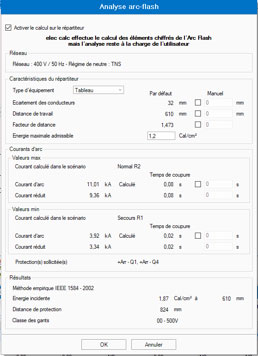In Europe, regulations and standardisation (e.g. the UTE C 18-510 publication in France) are mainly aimed at protecting workers against the risks of direct contact during work and interventions on and near electrical installations.
The risks in the event of an electric arc and the means to prevent them are mentioned but not explained.
In some countries, particularly in North America, these risks are better taken into account for the human, material and financial aspects, and regulations are much more restrictive in this area.
Why use the Arc Flash module?
- Avoiding the effects of arcing
- Electric arcs produce intense light and heat, loud noise and high overpressure
- Heat and molten metal splashes can cause fatal burns
- Noise can lead to temporary or permanent hearing impairments as well as flash vision disturbances
- Overpressure can open and project electrical cabinets doors or cause falls when working at height
- Assessing the risk: There is no method of risk analysis or assessment in the IEC or European standards. On the other hand, the United States has the following texts:
- NFPA 70E (Standard for Electrical Safety in the Workplace)
- Takes into account all electrical risks, including those due to electric arcs.
- Recommends PPE (Personal Protective Equipment) be used according to the level of risk
- IEEE 1584-2018 (Guide for Performing Arc-Flash Hazard Calculations)
- Gives the methods for calculating the incident energy in the event of an electric arc.
- Determines a dangerous approach distance
- NFPA 70E (Standard for Electrical Safety in the Workplace)
Features

Determine the three-phase short-circuit currents that are likely to occur on a splitter
from the operating scenarios described in a project
Calculation of the corresponding cut-off time for any affected protective devices
and provision of the corresponding results, in accordance with the calculation methods in IEEE Guide 1584-2018:
- The maximum incident energy at any given working distance
- The protection distance for the maximum permissible energy (1.2 Cal/cm²)
- The class of gloves (PPE) to be used to prevent the risk of electric shock (IEC 60903 and ASTM D120 standards)
Modification of labels for each piece of equipment concerned
or the export of the corresponding results to allow for the customisation of labels
Installation version monitoring
and anticipation of obsolescence for previously issued labels
Calculation of the encrypted elements of the flash arc
from which the user can develop their security analysis for the near vicinity of the panels and cabinets.
Determine the three-phase short-circuit currents that are likely to occur on a splitter
from the operating scenarios described in a project
Calculation of the corresponding cut-off time for any affected protective devices
and provision of the corresponding results, in accordance with the calculation methods in IEEE Guide 1584-2018:
- The maximum incident energy at any given working distance
- The protection distance for the maximum permissible energy (1.2 Cal/cm²)
- The class of gloves (PPE) to be used to prevent the risk of electric shock (IEC 60903 and ASTM D120 standards)
Modification of labels for each piece of equipment concerned
or the export of the corresponding results to allow for the customisation of labels
Installation version monitoring
and anticipation of obsolescence for previously issued labels
Calculation of the encrypted elements of the flash arc
from which the user can develop their security analysis for the near vicinity of the panels and cabinets.
Determine the three-phase short-circuit currents that are likely to occur on a splitter
from the operating scenarios described in a project
Calculation of the corresponding cut-off time for any affected protective devices
and provision of the corresponding results, in accordance with the calculation methods in IEEE Guide 1584-2018:
- The maximum incident energy at any given working distance
- The protection distance for the maximum permissible energy (1.2 Cal/cm²)
- The class of gloves (PPE) to be used to prevent the risk of electric shock (IEC 60903 and ASTM D120 standards)
Modification of labels for each piece of equipment concerned
or the export of the corresponding results to allow for the customisation of labels
Installation version monitoring
and anticipation of obsolescence for previously issued labels
Standards
The data taken into account:
The IEEE 1584-2018 guide provides the equations needed to determine risks.
Options taken into account for the calculation of the arc current and the reduced arc current:
- Three-phase short-circuit current
- Voltage
- Distance between members
- The type of equipment: open frame or panel / cabinet and their dimensions
- The electrode arrangement
Options taken into account for the incident energy:
- Arc current
- Protective run time for arc current and reduced arc current
- Voltage
- Working distance
- Open frame or panel/cabinet and their dimensions
- The electrode arrangement
- The grounding scheme
Compatibility with elec calc versions
The Arc Flash Module is compatible with all versions
